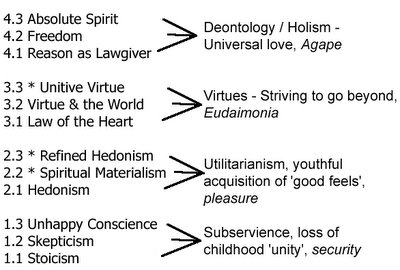Listening to Ken Wilber, and having just read Hegel’s Phenomenology of Spirit (or much of it for a course) I’ve decided to lay out some of the schemata of Hegel’s work, with some interpolations of my own.
Hegel’s work itself reads as a flow of the development of consciousness. It is famously opaque, and has been neglected, so my professor claims, mostly due to its breadth and difficulty (Ken Wilber may face similar shunning, from academics at least). Hegel’s development is that of Geist, or spirit, over the history of mankind, though it does not read as anything like a history text. I don’t want to spend too much time explaining it here (there are entire books devoted to the Preface of the Phenomenology of Spirit); I want to jump in and just toss out there, in its most stripped-down form, the entire history of the development of consciousness. However, I’ll do it in my own way, more as the development of a single human being than as the development of a superhistorical Geist.
It goes like this (starting at the bottom):
* indicates portions I have added, that are not explicit in Hegel’s text.
The last word, in italics, is also my own and represents the ideal hope/goal of individuals in each stage.
I actually wrote a philosophy paper a couple years back which compared Buddhism to the three common ethical systems in the West (Utilitarian/Virtue/Deontological – Mill/Aristotle/Kant) with it culminating in Kantian Deontology. Hegel presents himself as going beyond Kant, who is placed at the level of ‘Reason as Law-Giver’ in Hegel’s scheme. This short-changes Kant a bit, but has its element of truth.
Any thoughts on the scheme?











